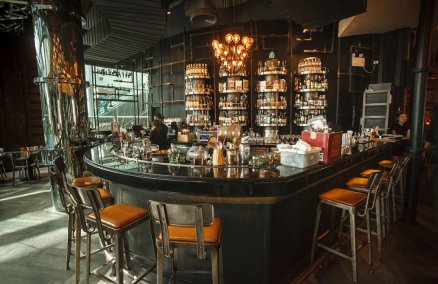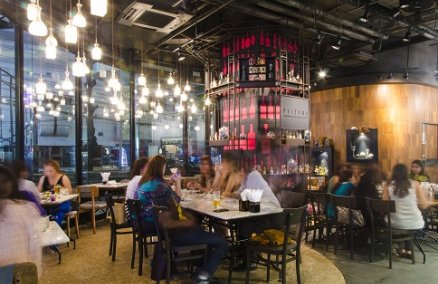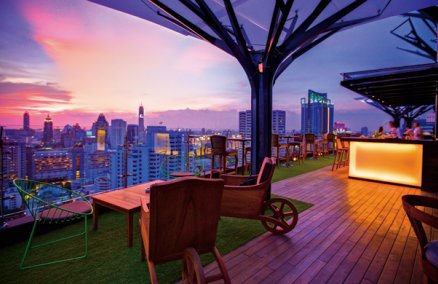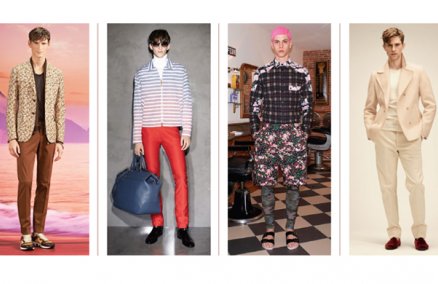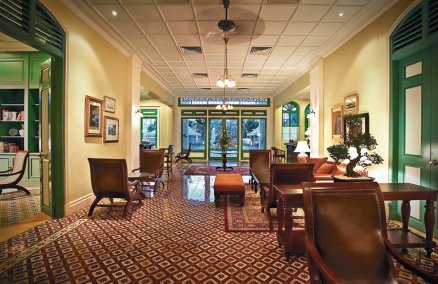Not Cutting Himself Short: Royston Tan
While he is most well-known for his 12-minute short film Cut (2004), where he spoofed the board of film censors and consequently got himself blacklisted from the industry for a period of time, bad boy of local film, director Royston Tan, has a slew of quality short films under his belt. They include the cutting-edge Jesses (1999), which used stop motion animation and haunting music, and the multiple award-winning Sons (2000), which also took home the best short film award at the 13th Singapore International Film Festival (SIFF).
But it was Cut that proved to be Tan’s most high profile film to date, as was the controversial 15, which centered on teenage gangs and which suffered 27 cuts before it was given an R(A) rating by the local censors. “I don’t try to project a squeaky clean image of myself on screen,” says Tan. “I’m not perfect … and making Cut was just an honest way for me to express myself to the cuts that had been made to 15,” he concedes.
Certainly, Tan’s immaculate visual style and uneasy themes have garnered him not just much press coverage, but a growing international fan base as well. Tan’s uncensored versions of 15 and Sons, for example, have been shown to critical acclaim in the US, Australia, Spain and Busan, to name just a few places. And he remains one of Singapore’s most successful filmmakers, who is consistently making films and garnering international awards.
While his latest feature film, the quiet and meditative 4.30, which premiered at the recent 56th Berlin International Film Festival and which will close this year’s SIFF, was a change in pace for Tan, rest assured he is not resting on his laurels yet. His next project? “A shocking film that Singapore is not prepared for,” he says with a little chuckle. “I’ve never wanted to be a bad boy … it’s just that I see things differently. I’ve never conformed since young, and I’m still experimenting and still very inquisitive.”
Fashion Forward: Song+Kelly21
Arguably Singapore’s most successful fashion label, 10-year-old Song+Kelly21 is best known for its girly, fuss-free collection of womenswear that straddles casual gear and high fashion. But more than just that, the label, which started as Raw in 1994, is known for paving the way for Singaporean fashion designers into the international fashion arena. During its peak, between 1998-1999, the clothes had high-profile showings in New York and London, and was the “It” Singaporean label to wear. “Who would have thought that I could ever get so excited over a homegrown label back then,” says fashion fan Lena Lee. “If there was a Singaporean label that I would splurge on, Song+Kelly21 would be it.”
Founded by Singaporean Wykidd Song and Briton Ann Kelly, the label has produced about 150 individual designs for each collection throughout its decade-long run. Throughout the years, Song+Kelly21 has been consistently stocked in many boutiques and department stores overseas, including Harrods (New York) and Selfridges (London). Today, the label is stocked in Bangkok, KL, London and Singapore. “When we first started the label, we had already planned to take it overseas,” says Song. “We wanted to set ourselves in the international arena and compete there, and see how we would fare. Over the past decade, there has been only one other Singaporean label that tries to push the edge in terms of design overseas, and that is WOODS & WOODS.”
Song+Kelly21 should be lauded for putting Singapore on the international fashion map, and further spurring inspiring Singaporean labels such as WOODS & WOODS (Jonathan Seow), Kwodrent (Grace Tan) and Hansel (Jo Soh) to make a splash overseas, namely in Europe and Australia.
“I really feel that our local designers are very talented. They just need the extra push, and be encouraged,” adds Song. “I would like to see more designers setting the pace for Singapore-bred labels on an international level. They need to get out there and compete, and be driven to maintain a certain quality.”
Let The Music Play: The Local Indie Music Scene
The recent local rock music revival has been a long time coming, and is spurred by an underground music scene that has been bubbling in music fans’ consciousness since the early ’90s. While the likes of solo artistes such as Singapore Idol Taufik Batisah and jazz crooner Jacintha Abishegenadan have been cutting relatively successful albums, it is the underground rock groups that lend the local music scene here its edge. Mostly self-funded, albums released by bands such as Concave Scream, The Padres, Plain Sunset, Sherene’s Closet, The Oddfellows, Livonia (and more recently, My Squared Circle, Tiramisu, Ronin and Lunarin) over the past decade have been lapped up by local music fans.
“I remember it still being very underground in the ’80s,” says Patrick Chng, The Oddfellows’ vocalist. “The local indie music scene is still very much underground today, but there’re a lot more bands which have made inroads into the mainstream. In the late ’80s, there was very little media exposure and only a handful of music stores stocked local demo cassettes. Then in the ’90s, we burst from the underground to mainstream radio success. What followed was a slew of local songs charting on radio. It was a great period for local music.”
Never mind that the spirit of local rock music scene was pretty much D-I-Y then, as most songs were produced onto cassettes and sold in small independent music stores such as Dada and Roxy Music. “Obviously today, the scene has gotten bigger and more structured … there is more exposure for local bands through the advent of the Internet, and more bands being signed up by the major labels,” says Sean Lam, vocalist of Concave Scream, which was recently signed up by EMI to release its latest album Horizon.
Bands such as Ronin and Electrico also released their albums over the past two years through major labels, but they concede that their music still has an indie vibe to them. “I’ll be the first to admit that hearing our songs being played on radio is a sign of going commercial to many … but underground and commercial music have to co-exist,” says Levan Wee, Ronin’s vocalist. “But we’ll always have that motor-mouth side to us that just can’t shut up. I guess that aspect of our music will never be too commercial.”
In fact, the loud swaggering nature of our local rock bands today is not very much different from those during the ’90s. As Concave Scream’s Lam says, “What goes on today is still pretty much how it was. The Oddfellows’ Chng agrees. “I would like to think we helped shaped the mentality of Singaporeans that local bands are cool to like,” he adds.
Way Out There: ZoukOut
It was the mother of all outdoor parties. The highly anticipated first ZoukOut in 2000 drew in almost 12,000 punters — an unprecedented number back then. While there have been other outdoor parties since, such as En Route at Altivo Bar, the mammoth ZoukOut — which cost $1 million to set up at Sentosa’s Siloso Beach and featured huge DJ names such as Dave Seaman, Richie Hawtin and Les Rythmes Digitales — was the most memorable and trendsetting of them all. It was the beach party to end all beach parties, as copycats which have sprouted since then failed to emulate its success.
“I think the whole idea of a festival was a new thing for most Singaporeans at the time,” says Andrew Ing, Zouk’s then-marketing manager, who came up with the idea to stage ZoukOut. “I used to travel to Miami every year for the Winter Music Conference, and I realized that Singapore and Miami have a lot in common in regard to the weather, but that’s about it. Miami is a sexy place, so why couldn’t Singapore be as sexy? Doing it on the beach allowed us to show the world that Singapore can be sexy too, with all those girls in their bikinis dancing and grinding to the music. And since December was also the rainy season, putting the party on the beach made sense. Throw in that elusive 6am license, and we knew we had a winner.”
Indeed, ZoukOut is such a winning formula, the following four installments — in 2001 (held at Sentosa’s Tanjong Beach), 2002 (Marina Bay Waterfront), 2004 (Siloso Beach) and 2005 (Siloso Beach) — have been equally successful, culminating with last year’s event that pulled in a record 18,000 revelers. Not only is ZoukOut the premier outdoor party here, but its popularity among many overseas punters also makes it an international dance music event that puts Singapore on the world map — with coverage from dance magazines such as Muzik and Mixmag. “All the different parts were ready for such an event — the people were ready, the setting of Sentosa was perfect, the DJs were ready, our team was ready, and Singapore was ready. We knew it would work,” says Ing.
Happy Days: The Local Gay Scene
It may have been a tad short-lived, but being gay was regarded as cool not too long ago. Well, sort of. The local gay community has undergone a paradigm shift over the past two years, following a general optimism among the community in 2003 when then-Prime Minister Goh Chok Tong acknowledged gays working in the civil service, and embraced the monetary clout of the pink dollar. Following that, Prime Minister Lee Hsien Loong also spoke of an “open and inclusive Singapore … (where) people should be free to express diverse views, pursue unconventional ideas or simply be different” in his inauguration speech that year.
But actions speak louder than words. Since then, numerous gay parties and events organized by gay portal Fridae.com, such as the annual Nation and Snoball parties, and most recently the Feelin’ Good gig at Ministry of Sound featuring Australian DJ Kate Monroe, have been banned or clamped down because of their gay content.
“Between 2000 and 2004, there was a huge explosion of sorts for the gay community,” says Fridae.com founder Stuart Koe. “Much of the crowd, that had been hiding underground for decades, were slowly coming out to party more, and hanging out at bars such as Taboo and Why Not. The advent of the Internet also kickstarted the scene, as many felt that it was an effective way for them to communicate. It allowed them the anonymity which some preferred, as well as for others to disseminate.”
But it was the massive and funky gay parties that ultimately brought the gay crowd together, especially the Nation parties that were held in Sentosa Island from 2001 to 2004. At its height, the party attracted more than 8,000 punters in 2004, of which 3,000 were tourists. “It was certainly good times among the community for a period of time,” says Koe. “The Nation parties were signs that the community was coming together … and because of it, Singapore became the center of attention with lots of press coverage. People were actually saying that Singapore was fun for once, and it was one of the best parties that they had ever attended.”
Soon enough, foreign media such as The Wall Street Journal and Far East Economic Review labeled Singapore the “gay capital of the world,” and the Singapore government clamped down on parties and events held by Fridae.com. The Nation parties have since moved to Phuket, Thailand, while Snoball is happening annually in Taipei. “The parties have generated good press for Singapore while they lasted, though,” concedes Koe. “It certainly made us cooler than usual … that Singapore was a cool place to live in. It’s more effective than any PR efforts that the Singapore Tourism Board could ever pay for.”
The Party Strip That Was: Mohamed Sultan
It was not dubbed “party central” for nothing. What started as a sleepy neighborhood with nary a partygoer in sight, Mohamed Sultan boomed into the place to party between 1995 and 1997, and later on between 1999 and 2001. Singapore’s nightlife experience was not complete without a visit to Mohamed Sultan, where some of the hippest and trendiest clubs such as Sugar, Club Eden, Amoeba, Nox and Lush were packing them in.
It all started in 1991, when ex-Business Times sub-editor Peter Wong installed a watering hole called Front Page for newspaper employees near Times House. Soon enough, bars and clubs sprouted left, right and center, and Mohamed Sultan became a club hopper’s paradise. But it wasn’t until the launch of Peter Wong and Simon Lim’s Wong San’s in 1994 that the stretch got put on the party map.
During its boom periods, the street attracted beautiful people, celebrities and big spenders. Some of the most famous faces seen at Mohamed Sultan include actor Jason Scott Lee, R&B diva Ultra Nate, late Hong Kong superstar Anita Mui, and actress Bai Ling. It also played host to some of the most lavish parties in town, including I-S Magazine’s fifth anniversary party, the first and only street party of its kind held along Mohamed Sultan, and hosted by Lim. “Back in those days, the street was heaving, and there were definitely more than a few cool concept bars and clubs that created a buzz,” says Lim. “Amoeba and Sugar were cutting edge … and there was a good overall mix, from expat bars to local bars to pool bars to dance clubs. It was a very interesting place for people to want to check it out.”
Partygoers certainly revved up the street then, as Mohamed Sultan was the only stretch where they could club hop all night. From the kitschy dance music at Sugar to leftfield dance tunes at Nox to beautiful chillout lounge Amoeba, there was something for everyone. While Mohamed Sultan has since disintegrated to just a regular bar stretch today, pulling in a younger set, the experience there was unforgettable for most who had frequented it almost every weekend. “There will always be some of us who spent the best of our party days in this area,” says Sugar’s Gary Sng, “At its peak there were so many clubs each with its own style and clientele, so I think different people will have different reasons for remembering Mohamed Sultan.”
Hipper Than Thou: Cool Neighborhoods
Over the last decade, with the impressive rise of prominent restaurants, pubs, hip fashion boutiques and unique features, once mostly tranquil residential areas and neighborhoods like Holland Village, Club Street and Arab Street have evolved from heartland havens to leading scenes all their own.
“Apollo would not have moved in if we weren’t there,” Michael Hadley, co-founder of Michelangelo’s, boldly proclaims of the restaurant’s impact on Holland Village. “We changed the perception of what Holland Village is. It was hardly recognized eight years ago, but after we opened three restaurants there, other people wanted to come in.”
Indeed, from just a few eateries, miscellaneous shops and even a kindergarten, Holland Village — with its influx of restaurants, reputable bars and boutiques like Harry’s Bar, Wala Wala and Antipodean — has certainly grown out of the shell of the looming HDB blocks into something of a scaled down version of more popular hot spots like Clarke Quay, attracting a clued-in, lifestyle driven, hip set.
Meanwhile, the Chinatown area, especially along Club Street, Ann Siang Hill and Duxton Hill, is where you can find exclusive fashion and lifestyle boutiques like Asylum, Allan Ross and Venue, and the many cafés, chillout joints and clubs that have come into their own over the past decade, giving the traditional neighborhood a contemporary facelift. The recently hip Arab Street is also where it’s at for some rare fashion finds from White Room and Comme des Garcons Guerilla Store, and cool sheesha cafes such as Mosi Café and Café Le Caire.
So what is it that really sets these places apart? The mix between the old and the new might have a lot to do with their appeal. “There’s a very eclectic mix of business and restaurants, and of course for the historical reference of Chinatown,” said Yaddo Art owner Abigail Prior Levy, on why she chose to set up in Duxton Hill.
These cultural hubs, however, are in danger of losing their particular X-factor … or, at least, that’s what Hadley seems to think about Holland Village. “I don’t think Holland Village has kept its edge,” he says bluntly. “The landlords are not working together and there are far too many owners. It’s not like a mall, where there’s a certain mix. There is no master plan.” Whether Hadley’s words will ring true for the future of the area remains to be seen. For now, these places still buzz with the crowds.
Young at Heart: Hip Conserved Historic Buildings
What’s old is new again … and it’s hotter than it ever was. With historic buildings set up for conservation, Singapore has managed to not only keep a part of its rich heritage intact, but has also spun something contemporary out of it.
Compared to the ’80s, when everything from the past was seemingly due for extinction, the ’90s saw us embracing our history. In the past decade, the Urban Redevelopment Authority (URA) has been actively conserving historic buildings either for their location or distinctive architectural style. To date around 6,800 buildings have been gazetted for conservation, including The Fullerton Hotel and various shophouses in Chinatown, Boat Quay, Clarke Quay and Arab Street.
Entrepreneur Loh Lik Peng has been pushing the boundary of this conservation effort, with his groovy boutique hotels the New Majestic Hotel, which opened just recently at Bukit Pasoh in Chinatown, and Hotel 1929 in 2002. “At the back of the 1929, we had a Jacuzzi, which was considered a novelty at the time,” he said. “We were also the first to have a sky garden, which was actually pretty controversial.” But Loh had to fight a little for his vision that was 11 years in the making. “The URA actually had a small issue with it, but they approved it in the end after some thorough discussions,” he adds.
Nevertheless, the hotels have now taken their places beside other conserved milestones such as the row of shophouses along Emerald Hill and Boat Quay. Loh, however, feels that there needs to be a limit to the rules of conservation, and that some artistic liberties still need to be taken to add a dash of modern and local elements to the buildings. “Having local artists provide an artistic component is one of the ways to incorporate local elements into these buildings, yet keeping them hip and modern all the same,” he explained. “Singapore still struggles with her identity, and I agree that a lot of this preservation is important. But at the end of the day, no one wants to stay in an ‘old’ place as it has a shelf life. ‘Updates’ on these conserved buildings are important to make them work.”
The URA and owners like Loh may still be trying to find that right balance of old and new, but for now, these landmarks remain some of the most stylish and unique on our streets, ever.
High Art: Local Theater Circa 1999-2001
Local theater has certainly seen better days. It was not very long ago when local theater companies such as TheatreWorks, Toy Factory Theatre Ensemble, The Necessary Stage (TNS) and Singapore Repertory Theatre (SRT) were at the forefront of quality and experimental theatrical productions which defined the burgeoning arts scene here.
Who could forget the much-talked about epics Lear (1999) and Desdemona (2000) by TheatreWorks’ controversial Artistic Director Ong Keng Sen, the onslaught of sex plays Asian Boys Vol. 1 by TNS, and smaller, more intimate dramatic gems such as Autumn Tomyam (2001) by ACTION Theatre, Titoudao (2000) by Toy Factory, and Eleemosynary (2001) by luna-ID. They were brave and unpredictable plays that made theatergoing a thoroughly enjoyable experience.
“There was a buzz and real sense of hope in theater in those early days between 1999 and 2001,” says Parvathi Nayar, correspondent for The Business Times. “It was as if new grounds were being broken then. The annual Singapore Arts Festival got into a new edge-of-the-moment mode, and there were also nice discussions and debates created by Lear and Desdemona. It felt that, all round, perhaps, wow, theater and the arts are on the way to becoming part of the stuff we discuss like the movies.”
Fueled by an increasing interest in the scene, directors such as the Toy Factory’s Goh Boon Teck and W!ld Rice’s Ivan Heng pushed the envelope with more forward thinking plays including A Tinted Edge (2000) and Animal Farm (2002) respectively, but that’s as good as it gets.
Soon enough, with the onslaught of SARS and the recession taking their toll, theater companies became more concerned with commercial viability and filling up seats in performance spaces, and their quality suffered, resulting in countless lackluster plays such as Dangerous Liaisons (2005), Mardi Gras (2003) and Spring Singing (2005). “Perhaps it was inevitable because harsh realities always overtake dreams,” adds Nayar. “That the struggle for survival is hard … with sponsorship, raising money and all that stuff. And sometimes you feel there is a lack of cohesiveness among the players with too many plays opening at the same time.”
Still, we are hopeful that local theater can revisit its earlier glory days, if the practitioners can put their heads together, and come up with more creative and groundbreaking plays that may not necessarily be commercial, but are bold statements in their own right, much like those from the later ’90s and early ’00s.
A Taste for Durian: Esplanade—Theatres on the Bay
It rose from the mud of the Marina Bay and, with its twin domes of metal spikes, attracted the glint of the sun and both bouquets and brickbats. Now, four years after it opened in 2002, there is little doubt that Esplanade—Theatres on the Bay has had a major impact upon Singapore, injecting life, color and energy into the cultural scene. The numbers speak for themselves: in 2005 the center welcomed over seven million visitors, a 39 percent increase on the previous year.
There were many—largely local artists—who predicted the center would flop because the local arts community would not be represented. But as J P Nathan, Director of Programming at The Esplanade Co. Ltd., explains: “One key focus for Esplanade since its opening has been to grow and nurture local talents in the Singapore arts industry across all fields. Some 30,000 from the local arts community [local talents involved in each performance] have been welcomed here, in a variety of venues ranging from outdoor to indoor spaces … non-ticketed to ticketed shows.”
The center has also encouraged shared knowledge, with musicians such as Jeremy Monteiro, The Observatory and Bushmen opening for star international acts James Moody, Tortoise and The Skatalites respectively, besides inviting artists to workshops by international talents. Indeed, you would be hard pressed to find a local artist who hasn’t worked with Esplanade.
And no, despite what your taxi driver will tell you, Esplanade isn’t just for the rich. Its 04/05 Annual Report reveals 799,745 people attended free performances, including ground-breaking events such as BayBeats and the New Year’s Eve Celebration. But perhaps Esplanade’s greatest achievement is the quality of the international acts being brought in. Non-commercial shows which would never reach our shores due to their esoteric, unprofitable nature—international legends such as kd lang, Patti Austin, Youssou N’Dour, Jessye Norman, Pat Methany, Poncho Sanchez, and Cloud Gate Dance Theatre, to name just a few—have dazzled audiences starved for star acts.
As to what international artists think of Esplanade, the vote is always unanimous. As Maceo Parker said, after opening for the 2006 Mosaic Music Festival, “The festival was organized to the highest standard. Everyone was wonderful and professional. I’ve participated in probably thousands of festivals worldwide and I would say this has been an experience to rate in the top five or six. It takes love and commitment to produce this kind of quality.”
A lot can change over the course of 10 years and here at I-S, we've compiled a little table of numbers to show you what are some of the changes that has taken place in our lives besides us morphing from being called "kor kor" and "jie jie" to today's "uncle" and "auntie"... Oh-the-horror...
Advertisement










